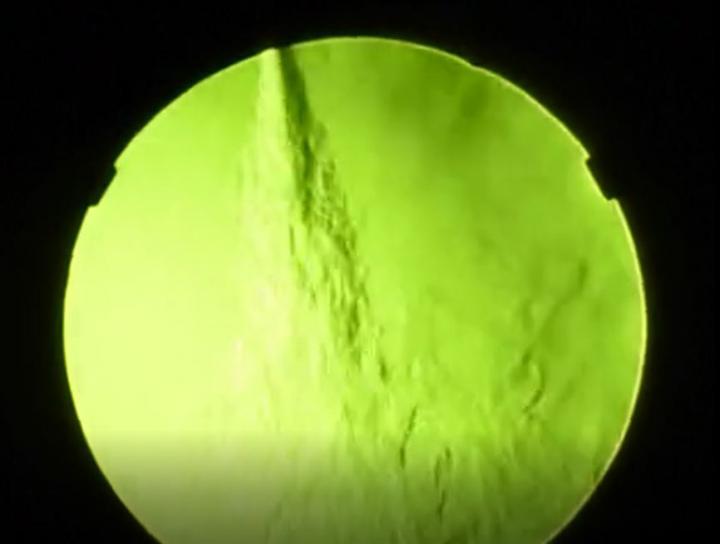
Credit: Young Kim/Purdue University
WEST LAFAYETTE, Ind. – The COVID-19 pandemic has shed new light on the needs for improved disinfection methods, both for individuals and facilities.
Purdue University innovators have developed an airborne disinfection method – using food-coloring dyes – to be applied to the entire body and rooms for sterilization purposes and lowering the risk of infection.
The Purdue team’s disinfection method uses edible materials. The Purdue team presented the technology in July during a COVID-19 virtual conference sponsored by the National Council of Entrepreneurial Tech Transfer.
The team is receiving support from Purdue’s Trask Innovation Fund, which helps labs commercialize their innovations.
“Most of the antiviral and antibacterial sprays used for airborne antiviral and antibacterial disinfectants, such as aerosolized hydrogen peroxide, ozone and deep ultraviolet illumination, are a biohazard risk to humans,” said Young Kim, an associate professor of biomedical engineering at Purdue. “Additionally, disinfectants containing titanium dioxide and noble metal nanoparticles pose carcinogenic and cytotoxicity risks.”
Kim also said new methods are needed since transmission of pathogens (viruses and bacteria) often occurs in the air and infection with pathogens is transmitted by an airborne route. The Purdue method might also help in medical settings, where healthcare workers typically are exposed to the disease-causing agents when they take off their personal protective equipment.
The Purdue airborne antiviral phototherapy technique uses small aerosols FDA-approved food coloring dyes to mitigate the risks of airborne transmissions of pathogens. This is referred to as Photodynamic Airborne Cleaner (PAC).
“We have demonstrated with our novel solution how visible light activation of several FDA-approved food coloring dyes generate singlet oxygen, which can be used to kill airborne pathogens,” Kim said. “In the medical community, it is well known that singlet oxygen is effective to inactivate viruses. We are developing a scalable aerosol generation system for the dyes, allowing uniform fog-like dispersion lingering in the air to minimize wetting and surface staining. In addition, as health care workers are often infected when removing PPE, this technology can be installed in a confined chamber for health care professionals to change PPE in hospital settings.”
The novel photoreactive arrangement can be used in rooms where many people are present at risk of airborne pathogen exposure.
The innovators are working with the Purdue Research Foundation Office of Technology Commercialization to license this patented technology.
###
The researchers are looking for partners to continue developing their technology. For more information on licensing and other opportunities, contact D.H.R. Sarma of OTC at [email protected] and mention track code 2020-KIM-69064.
About Purdue Research Foundation Office of Technology Commercialization
The Purdue Research Foundation Office of Technology Commercialization operates one of the most comprehensive technology transfer programs among leading research universities in the U.S. Services provided by this office support the economic development initiatives of Purdue University and benefit the university’s academic activities through commercializing, licensing and protecting Purdue intellectual property. The office recently moved into the Convergence Center for Innovation and Collaboration in Discovery Park District, adjacent to the Purdue campus. In fiscal year 2020, the office reported 148 deals finalized with 225 technologies signed, 408 disclosures received and 180 issued U.S. patents. The office is managed by the Purdue Research Foundation, which received the 2019 Innovation and Economic Prosperity Universities Award for Place from the Association of Public and Land-grant Universities. In 2020, IPWatchdog Institute ranked Purdue third nationally in startup creation and in the top 20 for patents. The Purdue Research Foundation is a private, nonprofit foundation created to advance the mission of Purdue University. Contact [email protected] for more information.
About Purdue University
Purdue University is a top public research institution developing practical solutions to today’s toughest challenges. Ranked the No. 6 Most Innovative University in the United States by U.S. News & World Report, Purdue delivers world-changing research and out-of-this-world discovery. Committed to hands-on and online, real-world learning, Purdue offers a transformative education to all. Committed to affordability and accessibility, Purdue has frozen tuition and most fees at 2012-13 levels, enabling more students than ever to graduate debt-free. See how Purdue never stops in the persistent pursuit of the next giant leap at purdue.edu.
Writer: Chris Adam, 765-588-3341, [email protected]
Source: Young Kim, [email protected]
Media Contact
Chris Adam
[email protected]




